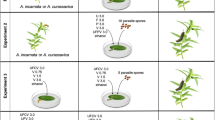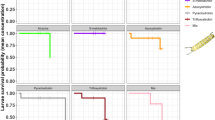Abstract
The pattern of variation in gross cardenolide concentration of 111Asclepias speciosa plants collected in six different areas of California is a positively skewed distribution which ranges from 19 to 344 μg of cardenolide per 0.1 g dry weight with a mean of 90 μg per 0.1 g. Butterflies reared individually on these plants in their native habitats ranged from 41 to 547 μg of cardenolide per 0.1 g dry weight with a mean of 179 μg. Total cardenolide per butterfly ranged from 54 to 1279 μg with a mean of 319 μg. Differences in concentrations and total cardenolide contents in the butterflies from the six geographic areas appeared minor, and there were no differences between the males and the females, although the males did weigh significantly more than females. The uptake of cardenolide by the butterflies was found to be a logarithmic function of the plant concentration. This results in regulation: larvae which feed on low-concentration plants produce butterflies with increased cardenolide concentrations relative to those of the plants, and those which feed on high-concentration plants produce butterflies with decreased concentrations. No evidence was adduced that high concentrations of cardenolides in the plants affected the fitness of the butterflies. The mean emetic potencies of the powdered plant and butterfly material were 5.62 and 5.25 blue jay emetic dose fifty units per milligram of cardenolide and the number of ED50 units per butterfly ranged from 0.28 to 6.7 with a mean of 1.67. Monarchs reared onA. speciosa, on average, are only about one tenth as emetic as those reared onA. eriocarpa. UnlikeA. eriocarpa which is limited to California,A. speciosa ranges from California to the Great Plains and is replaced eastwards byA. syriaca L. These two latter milkweed species appear to have a similar array of chemically identical cardenolides, and therefore both must produce butterflies of relatively low emetic potency to birds, with important ecological implications. About 80% of the lower emetic potency of monarchs reared on A. speciosa compared to those reared onA. eriocarpa appears attributable to the higher polarity of the cardenolides inA. speciosa. Thin-layer Chromatographie separation of the cardenolides in two different solvent systems showed that there are 23 cardenolides in theA. speciosa plants of which 20 are stored by the butterflies. There were no differences in the cardenolide spot patterns due either to geographic origin or the sex of the butterflies. As when reared onA. eriocarpa, the butterflies did not store the plant cardenolides withR f values greater than digitoxigenin. However, metabolic transformation of the cardenolides by the larvae appeared minor in comparison to when they were reared onA. eriocarpa. AlthoughA. eriocarpa andA. speciosa contain similar numbers of cardenolides and both contain desglucosyrioside, the cardenolides ofA. speciosa overall are more polar. ThusA. speciosa has no or only small amounts of the nonpolar labriformin and labriformidin, whereas both occur in high concentrations inA. eriocarpa. A. speciosa plants and butterflies also contain uzarigen, syriogenin, and possibly other polar cardenolides withR f values lower than digitoxin. The cardenolide concentration in the leaves is not only considerably less than inA. eriocarpa, but the latex has little to immeasurable cardenolide, whereas that ofA. eriocarpa has very high concentrations of several cardenolides. Quantitative analysis ofR f values of the cardenolide spots, their intensities, and their probabilities of occurrence in the chloroform-methanol-formamide TLC system produced a cardenolide fingerprint pattern very different from that previously established for monarchs reared onA. eriocarpa. This dispels recently published skepticism about the predictibility of chemical fingerprints based upon ingested secondary plant chemicals.
Similar content being viewed by others
References
Anon. 1972. Northeastern California. California State Automobile Association, 150 Van Ness Ave, San Francisco, California (map).
Anon. 1975a. Sequoia. California State Automobile Association, 150 Van Ness Ave, San Francisco, California (map).
Anon. 1975b. Solano and Yolo Counties. California State Automobile Association, 150 Van Ness Ave, San Francisco, California (map).
Anon. 1975c. Northwestern California. California State Automobile Association, 150 Van Ness Ave, San Francisco, California (map).
Anon. 1975d. Lake Tahoe Region. California State Automobile Association, 150 Van Ness Ave, San Francisco, California (map).
Anon. 1975e. Inyo County. Automobile Club of Southern California, 2601 South Figueroda St., Los Angeles, California.
Anon. 1982a. SAS User's Guide: Basics, 1982 Edition. SAS Institute, Inc., Gary, North Carolina, 923 pp.
Anon. 1982b. SAS User's Guide: Statistics, 1982 Edition. SAS Institute, Inc., Gary, North Carolina, 584 pp.
Bauer, Š., Masler, L., Bauerová, O., andŠikl, D. 1961. Uzarigenin and desglucouzarin fromAsclepias syriaca L.Experientia 17:15.
Blum, M.S. 1981. Chemical Defenses of Arthropods. Academic Press, New York, xii + 562 pp.
Blum, M.S. 1983. Detoxication, deactivation, and utilization of plant compounds by insects, Chapter 15, pp. 265–275,in P.A. Hedin (ed.). Plant Resistence to Insects. American Chemical Soc. Symposium Series No. 208.
Borkin, S.S. 1982. Notes on the shifting distribution patterns and survival of immatureDanaus plexippus (Lepidoptera: Danaidae) on the foodplantAsclepias syriaca.Great Lakes Entomol. 15:199–206.
Brower, L. P. 1984. Chemical defence in butterflies.Symp. R. Entomol Soc. London 11:109–134.
Brower, L.P., andCalvert, W.H. 1984. Dynamics of monarch butterfly overwintering colony formation, consolidation, and breakup in Mexico. In preparation.
Brower, L.P., andGlazier, S.C. 1975. Localization of heart poisons in the monarch butterfly.Science 188:19–25.
Brower, L.P., andMoffitt, C.M. 1974. Palatibility dynamics of cardenolides in the monarch butterfly.Nature 249:280–283.
Brower, L.P., McEvoy, P.B., Williamson, K.L., andFlannery, M.A. 1972. Variation in cardiac glycoside content of monarch butterflies from natural populations in eastern North America.Science 177:426–429.
Brower, L.P., Edmunds, M., andMoffitt, C.M. 1975. Cardenolide content and palatability ofDanaus chrysippus butterflies from West Africa.J. Entomol. (A) 49:183–196.
Brower, L.P., Seiber, J.N., Nelson, C.J., Lynch, S.P., andTuskes, P.M. 1982. Plantdetermined variation in the cardenolide content, thin layer chromatography profiles, and emetic potency of monarch butterflies,Danaus plexippus reared on the milkweed,Asclepias eriocarpa in California.J. Chem, Ecol. 8:579–633.
Brown, P., Von Euw, J., Reichstein, T., Stockel, K., andWatson, T.R. 1979. Cardenolides ofAsclepias syriaca L., probable structure of syrioside and syriobioside.Helv. Chim. Acta 62:412–441.
Calvert, W.H., Hedrick, L.E., andBrower, L.P. 1979. Mortality of the monarch butterfly (Danaus plexippus L.): Avian predation at five overwintering sites in Mexico.Science 204:847–851.
Cheung, H.T., andWatson, T.R. 1980. Stereochemistry of the hexulose in cardenolide glycosides of the Asclepiadaceae.J. Chem. Soc. Perkin 1:2162–2168.
Cheung, H.T. A., Watson, T.R., Seiber, J.N., andNelson, C. J. 1980. 7 β,8β-Epoxycardenolide glycosides ofAsclepias eriocarpa.J. Chem. Soc. Perkin 1:2169–2173.
Dixon, W.J.,andMassey, F.J., Jr. 1957. Introduction to Statistical Analysis, 2nd Ed. McGraw-Hill, New York, xiv + 488 pp.
Duffy, S.S., andScudder, G.G.E. 1972. Cardiac glycosides in North American Asclepiadaceae, a basis for unpalatability in brightly coloured Hemiptera and Coleoptera.J. Insect Physiol. 18:63–78.
Fink, L.S., andBrower, L.P. 1981. Birds can overcome the cardenolide defence of monarch butterflies in Mexico.Nature 291:67–70.
Fink, L.S., Brower, L.P., Waide, R.B., andSpitzer, P.R. 1983. Overwintering monarch butterflies as food for insectivorous birds in Mexico.Biotropica 15:151–153.
Masler, L., Bauer, S., Bauerová, O., andŜikl, D. 1962a. Herzglykoside der Seidenpflanze (Asclepiassyriaca L.). I. Isolierung der Herzwirksamen Steroide.Coll. Czech. Chem. Commun. 27:872–881.
Masler, L., Bauer, S., Bauerová, O., andŠikl, D. 1962b. Herzglykoside der Seidenpflanze (Asclepiassyriaca L.). II. Struktur von Syriogenin und seiner glykoside.Coll. Czech. Chem. Commun. 27:895–901.
Mitsuhashi, H., Hayashi, K., andTomimoto, K. 1970. Constituents of the Asclepiadaceae plants XXVIII. Components ofAsclepias syriaca.Chem. Pharm. Bull Jpn. 18:828–831.
Nelson, C.J., Seiber, J.N., andBrower, L.P. 1981. Seasonal and intraplant variation of cardenolide content in the California milkweed,Asclepias eriocarpa, and implications for plant defense.J. Chem. Ecol. 7:981–1010.
Petricic, J. 1967. Cardenolides of some species of the genusAsclepias.Farm. Glas. 23:3–8 (Chem. Abst. 67:8686g).
Rawlins, J.E., andLederhouse, R.C. 1981. Developmental influences of thermal behavior on monarch caterpillars. (Danaus plexippus): An adaptation for migration (Lepidoptera: Nymphalidae: Danainae).J. Kans. Entomol. Soc. 54:387–408.
Roeske, C.N., Seiber, J.N., Brower, L.P., andMoffitt, C.M. 1976. Milkweed cardenolides and their comparative processing by monarch butterflies (Danus plexippus L.).Rec. Adv. Phytochem. 10:93–167.
Rothschild, M., Von Euw, J., Reichstein, T., Smith, D.A.S., andPierre, J. 1975. Cardenolide storage inDanaus chrysippus (L.) with additional notes onDanaus plexippus (L.).Proc. R. Soc. London B. 190:1–31.
Schmid, L., andLudwig, E. 1927. Two sterol-like compounds fromAsclepias syriaca.Monatsh 48:577–583.
Seiber, J.N., Tuskes, P.M., Brower, L.P., andNelson, C.J. 1980. Pharmacodynamics of some individual milkweed cardenolides fed to larvae of the monarch butterfly (Danausplexippus L.).J. Chem. Ecol. 6:321–339.
Seiber, J.N., Nelson, C.J., andLee, S.M. 1982. Cardenolides in the latex and leaves of sevenAsclepias species andCalotropis procera.Phytochemistry 21:2343–2348.
Seiber, J.N.,Lee, S.M., andBenson, J.M. 1983. Cardiac glycosides (cardenolides) in species ofAsclepias (Asclepiadaceae). R.F. Keeler and A.T. Tu (eds.), inEncyclopedic Handbook of Natural Toxins, Vol. 1, Plant Toxins, pp. 43–83.
Shapiro, A.M. 1974. The butterfly fauna of the Sacramento Valley, California.J. Res. Lepid. 13:73–82.
Sokal, R.R., andRohlf, F.J. 1969. Biometry. W.H. Freeman and Co., San Francisco, xxii + 776 pp.
Stahl, E. 1965. Instruments used in thin layer chromatography and their operation, pp. 5–29, 134–136,in E. Stahl (ed.). Thin Layer Chromatography, A Laboratory Handbook. Springer-Verlag, Berlin.
Steel, R.G.D., andTorrie, J.H. 1960. Principles and Procedures of Statistics. McGraw Hill, New York, xvi + 481 pp.
Tuskes, P.M., andBrower, L.P. 1978. Overwintering ecolgy of the monarch butterfly,Danaus plexippus, in California.Ecol. Entomol. 3:141–153.
Urquhart, F.A. 1960.The Monarch Butterfly. University of Toronto, Press, Toronto, Canada, xxiv + 361 pp.
Urquhart, F.A., andUrquhart, N.R. 1979. Breeding areas and overnight roosting locations in the northern range of the monarch butterfly (Danaus plexippus plexippus) with a summary of associated migratory routes.Can. Field Nat. 93:41–47.
Urquhart, F.A., andUrquhart, N.R. 1980. Migration studies of the monarch butterfly in North America.Nat. Geog. Soc. Res. Rep. 1971 12:721–730.
Van Emon, J., andSeiber, J.N. 1984. Chemical constituents and energy content of two milkweed (Asclepias) species. InJ. Economic Botany, in press.
Whiting, A.G. 1943. A summary of the literature on milkweeds (Asclepias spp.) and their utilization.Bibliogr. Bull. U.S.D.A. No. 2, pp. 1–41.
Woodson, R.E., Jr. 1954. The North American species ofAsclepias L.Ann. Mo. Bot. Garden 41:1–211.
Author information
Authors and Affiliations
Additional information
Lepidoptera: Danaidae.
Apocynales: Asclepiadaceae.
This study was supported by U.S. National Science Foundation grants DEB 75-14265 and 78-10658 to Amherst College and BSR-8119382 to the University of Florida with L.P. Brower as Principal Investigator and DEB75-14266, DEB78-15419, and DEB-81-19391 to the University of California at Davis with J.N. Seiber as Principal Investigator.
Rights and permissions
About this article
Cite this article
Brower, L.P., Seiber, J.N., Nelson, C.J. et al. Plant-determined variation in the cardenolide content, thin-layer chromatography profiles, and emetic potency of monarch butterflies,Danaus plexippus L. Reared on milkweed plants in California: 2.Asclepias speciosa . J Chem Ecol 10, 601–639 (1984). https://doi.org/10.1007/BF00994224
Received:
Revised:
Issue Date:
DOI: https://doi.org/10.1007/BF00994224
Key words
- Danaus plexippus
- Lepidoptera
- Danaidae
- monarch butterflies
- Asdepias speciosa
- Asclepiadaceae
- milkweeds
- ecological chemistry
- plant-insect interactions
- chemical ecology
- chemical defense
- coevolution
- thin-layer chromatography
- cardenolide fingerprints
- cardenolides
- cardiac glycosides
- desglucosyrioside
- labriformin
- labriformidin
- syriogenin
- uzarigenin
- emetic potency
- emesis




